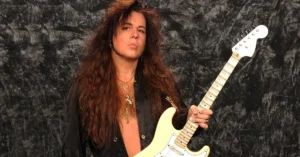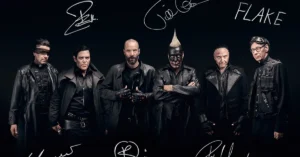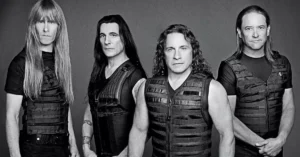Megadeth: Precision, Power, and the Politics of Thrash
Megadeth. Formation and Origins
Formed: 1983
Origin: Los Angeles, California, USA
Founder: Dave Mustaine – vocals, guitar, songwriter
Dave Mustaine founded Megadeth shortly after being fired from Metallica due to substance issues and personal conflict. Fueled by rage and a desire to outdo his former band, Mustaine vowed to create something faster, heavier, and more complex.
Megadeth. Early lineup (most prominent):
- Dave Mustaine – Vocals, lead guitar
- David Ellefson – Bass
- Various drummers and guitarists cycled through the band before stabilizing in later years
The name “Megadeth” comes from a term meaning one million deaths, taken from a nuclear war pamphlet — foreshadowing the band’s dark, politically charged themes.
Megadeth. Early Thrash Era and Breakthrough (1985–1990)
✦ Killing Is My Business… and Business Is Good! (1985)
- Raw, aggressive debut funded with leftover drug money
- Notable for its speed, ferocity, and Mustaine’s snarling vocals
- Included “Mechanix,” an early version of Metallica’s “The Four Horsemen”
✦ Peace Sells… But Who’s Buying? (1986)
- A major leap forward — tighter production and more complex arrangements
- Title track “Peace Sells” became an MTV hit and anti-establishment anthem
- “Wake Up Dead,” “Devils Island” – showcase dark humor and dystopian themes
This album cemented Megadeth as thrash innovators alongside Metallica, Slayer, and Anthrax.
✦ So Far, So Good… So What! (1988)
- Featuring “In My Darkest Hour,” written after the death of Cliff Burton
- Continued their ascent, though plagued by substance abuse and lineup changes
Megadeth. Mastery and Mainstream Crossover (1990–1994)
✦ Rust in Peace (1990)
- Often regarded as Megadeth’s masterpiece
- Introduced virtuoso guitarist Marty Friedman
- Intricate, fast, and politically furious
- Highlights:
- “Holy Wars… The Punishment Due” – A multi-section epic about war and religion
- “Hangar 18” – UFO conspiracy and shredding solos
- “Tornado of Souls” – Considered one of Friedman’s finest guitar performances
Rust in Peace is consistently listed among the greatest metal albums of all time.
✦ Countdown to Extinction (1992)
- More accessible without sacrificing bite
- Entered Billboard at #2, becoming their best-selling album
- Tracks:
- “Symphony of Destruction” – A heavy metal anthem
- “Sweating Bullets,” “Foreclosure of a Dream”
Megadeth balanced technical brilliance with stadium-sized choruses, briefly appealing to a mainstream metal audience.
Megadeth. Mid-90s to Early 2000s: Experimentation and Turmoil
✦ Youthanasia (1994)
- Polished and melodic, featuring songs like “A Tout le Monde” and “Train of Consequences”
- Divided fans — more accessible, less thrashy
✦ Cryptic Writings (1997)
- Featured the hit “Trust”
- Marked a shift toward radio rock, gaining new fans
✦ Risk (1999)
- A controversial album that flirted with electronic rock and arena pop
- Widely panned by fans; Mustaine later admitted it was a mistake
After David Ellefson left and Mustaine suffered a nerve injury in 2002, the band briefly disbanded.
Comeback and Modern Era (2004–Present)
✦ The System Has Failed (2004)
- A return to form, featuring Mustaine and session musicians
- “Die Dead Enough,” “Kick the Chair” revisited political fury
✦ United Abominations (2007), Endgame (2009)
- Critical return to aggressive roots
- “Head Crusher,” “Washington Is Next!” — complex, thrashy, relevant
✦ Th1rt3en (2011), Super Collider (2013)
- Mixed reviews, with Super Collider criticized for commercial leanings
✦ Dystopia (2016)
- Marked a major revival
- Won Grammy Award for Best Metal Performance (for the title track)
- Features guitarist Kiko Loureiro (ex-Angra) and drummer Dirk Verbeuren
✦ The Sick, The Dying… and the Dead! (2022)
- A solid mix of old-school thrash and modern themes
- Tracks like “We’ll Be Back” and “Night Stalkers” prove Mustaine’s fire still burns
Musical Style and Themes
Megadeth’s music combines:
- Technical thrash guitar work
- Complex song structures
- Dystopian, political, and philosophical lyrics
- Speed metal precision and snarling delivery
Lyrical themes:
- Nuclear war, government control, addiction, betrayal, surveillance, war, corruption
- Satirical takes on religion, finance, and media
Unlike Metallica’s more emotional tone, Megadeth often sounds cynical, confrontational, and fiercely intelligent.
Legacy and Influence
Megadeth is one of the “Big Four” of thrash metal, alongside:
They’ve sold over 50 million records, earned numerous Grammy nominations, and helped define modern heavy metal’s technical and thematic possibilities.
Influenced:
- Lamb of God, Trivium, Avenged Sevenfold
- Progressive metal and technical death metal bands
- Politically charged acts in both metal and punk
Interesting Facts
- Dave Mustaine is the only original member to appear on every Megadeth album
- He is a born-again Christian and outspoken about politics, often stirring controversy
- The band’s mascot, Vic Rattlehead, appears on nearly every album cover
- Dave Ellefson was fired in 2021 over a scandal, despite having played on many classic albums
- The band’s early music was blacklisted by MTV due to violent lyrics — something Mustaine often mocked





